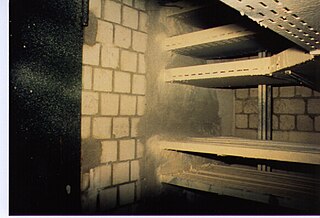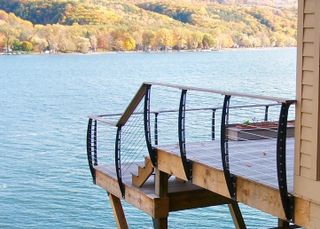
Barbed wire, also known as barb wire, occasionally corrupted as bobbed wire or bob wire, is a type of steel fencing wire constructed with sharp edges or points arranged at intervals along the strands. It is used to construct inexpensive fences and is used atop walls surrounding secured property. It is also a major feature of the fortifications in trench warfare.

Rebar, known when massed as reinforcing steel or reinforcement steel, is a steel bar or mesh of steel wires used as a tension device in reinforced concrete and reinforced masonry structures to strengthen and aid the concrete under tension. Concrete is strong under compression, but has weak tensile strength. Rebar significantly increases the tensile strength of the structure. Rebar's surface is often deformed to promote a better bond with the concrete.

In agriculture, fences are used to keep animals in or out of an area. They can be made from a wide variety of materials, depending on terrain, location and animals to be confined. Most agricultural fencing averages about 4 feet (1.2 m) high, and in some places, the height and construction of fences designed to hold livestock is mandated by law.

Prestressed concrete is a form of concrete used in construction that while under construction is substantially "prestressed" (compressed) in the areas that will be subjected to tensile forces while in service to strengthen it against these forces.

A Jersey barrier, or Jersey wall, is a modular concrete or plastic barrier employed to separate lanes of traffic. It is designed to minimize vehicle damage in cases of incidental contact while still preventing vehicle crossovers resulting in a likely head-on collision. Jersey barriers are also used to reroute traffic and protect pedestrians and workers during highway construction, as well as temporary and semi-permanent protections against landborne attack such as suicide vehicle bombs. A Jersey barrier is also known in the western United States as K-rail, a term borrowed from the California Department of Transportation specification for temporary concrete traffic barriers, or colloquially as a Jersey bump. Plastic water-filled barriers of the same general shape are also now commonly called Jersey barriers.

A utility pole is a column or post used to support overhead power lines and various other public utilities, such as electrical cable, fiber optic cable, and related equipment such as transformers and street lights. It can be referred to as a transmission pole, telephone pole, telecommunication pole, power pole, hydro pole, telegraph pole, or telegraph post, depending on its application. A stobie pole is a multi-purpose pole made of two steel joists held apart by a slab of concrete in the middle, generally found in South Australia.
A power cable is an electrical cable, an assembly of one or more electrical conductors, usually held together with an overall sheath. The assembly is used for transmission of electrical power. Power cables may be installed as permanent wiring within buildings, buried in the ground, run overhead, or exposed.

Wire rope is several strands of metal wire twisted into a helix forming a composite "rope", in a pattern known as "laid rope". Larger diameter wire rope consists of multiple strands of such laid rope in a pattern known as "cable laid".

A chain-link fence is a type of woven fence usually made from galvanized or LLDPE-coated steel wire. The wires run vertically and are bent into a zig-zag pattern so that each "zig" hooks with the wire immediately on one side and each "zag" with the wire immediately on the other. This forms the characteristic diamond pattern seen in this type of fence.

Passive fire protection (PFP) is an integral component of the components of structural fire protection and fire safety in a building. PFP attempts to contain fires or slow the spread, such as by fire-resistant walls, floors, and doors. PFP systems must comply with the associated listing and approval use and compliance in order to provide the effectiveness expected by building codes.

In the electrical wiring of buildings, a cable tray system is used to support insulated electrical cables used for power distribution, control, and communication. Cable trays are used as an alternative to open wiring or electrical conduit systems, and are commonly used for cable management in commercial and industrial construction. They are especially useful in situations where changes to a wiring system are anticipated, since new cables can be installed by laying them in the tray, instead of pulling them through a pipe.

A bicycle parking rack, usually shortened to bike rack and also called a bicycle stand, is a device to which bicycles can be securely attached for parking purposes. A bike rack may be free standing or it may be securely attached to the ground or some stationary object such as a building. Indoor bike racks are commonly used for private bicycle parking, while outdoor bike racks are often used in commercial areas. General styles of racks include the Inverted U, Serpentine, Bollard, Grid, and Decorative. The most effective and secure bike racks are those that can secure both wheels and the frame of the bicycle, using a bicycle lock.

Cable railings or wire rope railings are safety rails that use horizontal or vertical cables in place of spindles, glass and mesh for infill.

A concrete step barrier is a safety barrier used on the central reservation of motorways and dual carriageways as an alternative to the standard steel crash barrier.

A cable barrier, sometimes referred to as guard cable or wire rope safety barrier (WRSB), is a type of roadside or median safety traffic barrier/guard rail. It consists of steel wire ropes mounted on weak posts. As is the case with any roadside barrier, its primary purpose is to prevent a vehicle from leaving the traveled way and striking a fixed object or terrain feature that is less forgiving than itself. Also similar to most roadside barriers, cable barriers function by capturing and/or redirecting the errant vehicle.

The construction of State Farm Center, originally known as the Assembly Hall, at the University of Illinois at Urbana–Champaign consisted of building a huge indoor arena with a 400-foot-diameter (120 m) concrete dome whose center height is 125 feet (38 m) above the center floor, and which weighs 10 million pounds. The building is considered an engineering marvel because of the unique method used to build the concrete roof. State Farm Center, the first-ever concrete dome arena, hosts the campus's teams in men's and women's basketball, numerous concerts and other events. It holds sentimental value for numerous alumni and fans alike and attracts attention for its design and construction. The construction of the Assembly Hall was conceived to provide UIUC with needed space for ceremonies and athletic events. The university’s population had outgrown the largest building on campus at that time, the Auditorium, and desired one building that could hold the entire university class. The design of the new building, by Max Abramovitz, called for the construction of one of the world’s largest edge-supported structure. The assembly hall was completed in 1963, and was dedicated on Honors Day, Friday May 3.

Copper has been used in electrical wiring since the invention of the electromagnet and the telegraph in the 1820s. The invention of the telephone in 1876 created further demand for copper wire as an electrical conductor.

An electrical conduit is a tube used to protect and route electrical wiring in a building or structure. Electrical conduit may be made of metal, plastic, fiber, or fired clay. Most conduit is rigid, but flexible conduit is used for some purposes.
This page is a glossary of Prestressed concrete terms.
PC Strand, or prestressed concrete steel strand, is a twisted steel cable composed of 2, 3, 7 or 19 high strength steel wires and is stress-relieved (stabilized) for prestressed concrete or similar purposes.


















